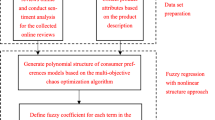Abstract
With the growth of the Internet and electronic commerce, more and more customers browse online reviews to understand products and service reputation. Online reviews can provide decision support for customers to purchase a product that is to their satisfaction. Manufacturers can also mine and analyze valuable information in favor of design and production from online reviews. Customer satisfaction is mainly determined by perceived quality of products. Hence, this study establishes a new method to evaluate the perceived quality by combining text mining with a fuzzy comprehensive evaluation method. The new evaluation method offers ideas and methods for future work to combine text mining technology with traditional evaluation methods. Customers can also make better purchase decisions and manufacturers design and manufacture better products by using this evaluation method.
Similar content being viewed by others
References
Bai, C. (2001). Western customer value research and practice implications. Nankai Business Review, 4(2), 51–55.
Liang, Y. (2003). Study on some problems of customer satisfaction index. Statistical Research, 20(11), 52–56.
Oliver, R. L., Shor, M., & Tidd, S. T. (2004). Induced over-benefiting and under-benefiting on the web: Inequity effects on feelings and motivations with implications for consumption behavior. Motivation and Emotion, 28(1), 85–106.
Snoj, B., Korda, A. P., & Mumel, D. (2004). The relationships among perceived quality, perceived risk and perceived product value. Journal of Product & Brand Management, 13(3), 156–167.
Ye, R., Tang, W. J., & Xu, K. T. (2009). China customer satisfaction evaluation model and application. Working paper, Customer Satisfaction Evaluation Center of China Standardization Research Institute.
Li, B., Xu, X., & Zhang, J. X. (2014). Research on product evaluation method by using micro-blog data—Taking “Android system” as an Example. Modern Library and Information Technology, 4, 92–98.
Huang, L. L. (2014). Product evaluation methods in the era of big data—A case study of the text data analysis of the customer’s online comments. Luojia Management Review, 1, 129–141.
Qian, J., Fan, B., Wu, X., Han, S., Liu, S., & Yang, X. (2016). Comprehensive and quantifiable granularity: A novel model to measure agro-food traceability. Food Control, 74, 98–106.
Kumar, P., & Singh, D. (2011). Integrating data mining and AHP for life insurance product recommendation. Computational Intelligence and Information Technology (pp. 596–602). Berlin: Springer.
Pang, B., Lee, L., & Vaithyanathan, S. (2002). Thumbs up?: Sentiment classification using machine learning techniques. In Acl-02 conference on empirical methods in natural language processing (pp. 79–86). Association for Computational Linguistics.
Godbole, N., Srinivasaiah, M., & Skiena, S. (2007). Large-scale sentiment analysis for news and blogs. In International conference on weblogs and social media (pp. 219–222).
Lin, C., & He, Y. (2009). Joint sentiment/topic model for sentiment analysis. In ACM Conference on information and knowledge management (Vol. 217, pp. 375–384). ACM.
Popescu, A. M. (2005). Extracting product features and opinions from reviews. In Hlt/emnlp on interactive demonstrations (pp. 32–33). Association for Computational Linguistics.
Turney, P. D. (2002). Thumbs up or thumbs down?: Semantic orientation applied to unsupervised classification of reviews. In Proceedings of annual meeting of the association for computational linguistics, (pp. 417–424).
Gao, T., Song, J. Y., Ding, J. H., & Wang, D. Q. (2017). Clustering algorithm based on fuzzy comprehensive evaluation for wireless sensor networks. International Journal of Wireless Information Networks, 24(1), 1–13.
Zhou, R., & Chan, A. H. S. (2017). Using a fuzzy comprehensive evaluation method to determine product usability: A test case. Work, 56(1), 21–29.
Jin, J. L., Wei, Y. M., & Ding, J. (2004). Fuzzy comprehensive evaluation model based on improved analytic hierarchy process. Journal of Hydraulic Engineering, 2, 144–147.
Acknowledgements
This research is supported by the Natural Science Foundation of China (71403138), the Shandong Humanities and Social Sciences Research Program of Colleges and Universities (J16YF15), and the Qingdao Social Science Program (QDSKL1601077).
Author information
Authors and Affiliations
Corresponding author
Rights and permissions
About this article
Cite this article
He, L., Zhang, N. & Yin, L. The evaluation for perceived quality of products based on text mining and fuzzy comprehensive evaluation. Electron Commer Res 18, 277–289 (2018). https://doi.org/10.1007/s10660-018-9292-0
Published:
Issue Date:
DOI: https://doi.org/10.1007/s10660-018-9292-0




